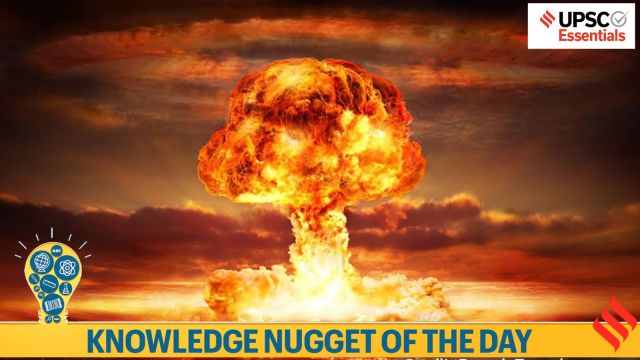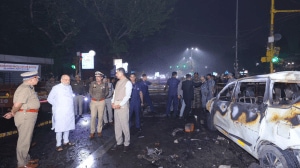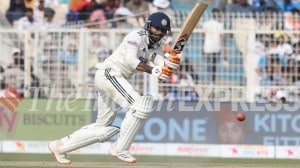
Why in the news?

Iran has further increased its stockpile of uranium enriched to near weapons-grade levels, a confidential report by the U.N. nuclear watchdog said Saturday. In a separate report, the agency called on Tehran to urgently change course and comply with its years-long probe.
Story continues below this ad
According to the International Atomic Energy Agency (IAEA), as of May 17, Iran has accumulated 408.6 kilograms of uranium enriched up to 60 per cent—a 50 per cent rise from February’s 274.8 kilograms. This level is just a technical step away from the 90 per cent enrichment needed for nuclear weapons. In this context, let’s understand why uranium enrichment is crucial for nuclear weapons.
Key Takeaways :
1. Atoms are the basic building blocks of all matter, such that they cannot be “broken down” further by simple chemical processes. Most of an atom is empty space. The rest comprises three basic types of subatomic particles — positively charged protons, negatively charged electrons, and the neutral neutrons. The protons and neutrons combine to form the atom’s nucleus, around which circle a “cloud” of electrons.
2. The number of protons in an atom determines the element, and the number of neutrons determines the isotope of that element. Different isotopes of the same element have the same chemical properties, but very different nuclear properties.
3. Most atoms on Earth are stable due to an equilibrated composition of neutrons and protons in their nucleus. However, in some unstable atoms, the composition of the number of protons and neutrons is such that it does not allow the nucleus to hold itself together.
Story continues below this ad
4. Such atoms are known to be radioactive, and they tend to break apart or fission into two lighter elements. This is the basis of most nuclear weapons and atomic energy.
5. Uranium-235, an extremely rare isotope of the heavy metal uranium, is the most commonly used nuclear fuel, as it is one of the few elements that can undergo induced fission. This means that the element can be broken down very quickly by a process put into motion by humans.
6. This is done by subjecting a U-235 nucleus to neutrons. The nucleus immediately absorbs an extra neutron and consequently becomes unstable — and immediately breaks apart into two lighter atoms, and a few extra neutrons. This process releases what is known as atomic energy.
7. The fission of a U-235 atom produces about 2 to 3 new neutrons on average. If these new neutrons are then absorbed by other U-235 atoms, it creates an exponentially growing chain reaction. The math is simple: with each ‘generation’ into the chain reaction, the number of atoms engaged can increase by 2 to 3 times.
Story continues below this ad
 Schematic diagram of a fission chain reaction. A U-235 atom absorbs a neutron, and fissions into two new atoms (fission fragments), releasing three new neutrons and some binding energy. Even if only one of these new neutrons collides with a U-235 atom (as shown in this graphic), which then fissions and releases two neutrons and some binding energy, the chain reaction continues. (Wikimedia Common)
Schematic diagram of a fission chain reaction. A U-235 atom absorbs a neutron, and fissions into two new atoms (fission fragments), releasing three new neutrons and some binding energy. Even if only one of these new neutrons collides with a U-235 atom (as shown in this graphic), which then fissions and releases two neutrons and some binding energy, the chain reaction continues. (Wikimedia Common)
8. Even though not all neutrons engage in the fission process, as long as each fission leads to more than one additional fission, the chain reaction grows exponentially and releases large amounts of energy.
9. Approximately 99.3% of naturally occurring uranium is of the isotope U-238, which is not fissionable. Naturally occurring uranium, therefore, cannot be used in a weapon, or for that matter, in nuclear power plants.
10. Thus, uranium ore is enriched in order to increase the concentration of U-235. Most nuclear power plants require an enrichment of 3-4% U-235 to sustain a chain reaction. Fission bombs on the other hand need closer to 90% enrichment.
11. This is done in specific enrichment facilities using some extremely complex equipment. Notably, the equipment needed to enrich fuel for nuclear power generations is the same as that needed to enrich it for a bomb — leading to one of the great challenges of enforcing nuclear non-proliferation.
Story continues below this ad
BEYOND THE NUGGET: Top 9 nuclear-armed countries in 2025
1. Today, the world is precariously standing at the brink of nuclear weapons proliferation, primarily due to unprecedented insecurity and rising geopolitical tensions. Although it seems that significant progress has been made to limit nuclear arsenals since the Cold War, the pace of reduction has considerably slowed down, leaving the global stockpile of nuclear warheads at alarmingly high levels.
2. According to the Federation of American Scientists (FAS) study, the top nine nuclear-armed nations collectively possess around 12,331 warheads as of early 2025. The top 9 nuclear-armed countries in the world, as of early 2025 are:
3. Notably, the ‘two superpowers’ from the Cold War period, the United States and Russia, collectively hold about 88% of the world’s total nuclear arsenal and 84% of the warheads that are readily available for military use. However, presently, both nations are taking gradual steps to diminish their stockpiles through the dismantling of decommissioned warheads; several other countries—such as China, India, and Pakistan—are reportedly expanding their nuclear inventories.
Post Read Questions
(1) Consider the following statements with regard to the Uranium-235:
1. It is an extremely rare isotope of the heavy metal uranium.
2. It is the most commonly used nuclear fuel.
Which of the statements given above is/are correct?
(a) 1 only
(b) 2 only
(c) Both 1 and 2
(d) Neither 1 nor 2
(2) Consider the following countries: (UPSC CSE 2015)
1. China.
2. France
3. India
4. Israel
5. Pakistan
Which among the above are Nuclear Weapons States as recognized by the Treaty on the Non-Proliferation of Nuclear Weapons, commonly known as Nuclear Non-Proliferation Treaty (NPT)?
(a) 1 and 2 only
(b) 1, 3, 4 and 5 only
(c) 2, 4 and 5 only
(d) 1, 2, 3, 4 and 5
Story continues below this ad
Subscribe to our UPSC newsletter. Stay updated with the latest UPSC articles by joining our Telegram channel – Indian Express UPSC Hub, and follow us on Instagram and X.
🚨 Click Here to read the UPSC Essentials magazine for May 2025. Share your views and suggestions in the comment box or at manas.srivastava@indianexpress.com🚨




 Schematic diagram of a fission chain reaction. A U-235 atom absorbs a neutron, and fissions into two new atoms (fission fragments), releasing three new neutrons and some binding energy. Even if only one of these new neutrons collides with a U-235 atom (as shown in this graphic), which then fissions and releases two neutrons and some binding energy, the chain reaction continues. (Wikimedia Common)
Schematic diagram of a fission chain reaction. A U-235 atom absorbs a neutron, and fissions into two new atoms (fission fragments), releasing three new neutrons and some binding energy. Even if only one of these new neutrons collides with a U-235 atom (as shown in this graphic), which then fissions and releases two neutrons and some binding energy, the chain reaction continues. (Wikimedia Common)






























